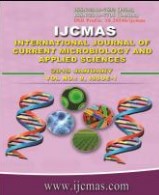


 National Academy of Agricultural Sciences (NAAS)
National Academy of Agricultural Sciences (NAAS)

|
PRINT ISSN : 2319-7692
Online ISSN : 2319-7706 Issues : 12 per year Publisher : Excellent Publishers Email : editorijcmas@gmail.com / submit@ijcmas.com Editor-in-chief: Dr.M.Prakash Index Copernicus ICV 2018: 95.39 NAAS RATING 2020: 5.38 |
The Indian Sundarbans is a coastal delta and major climate hotspot located in the state of West Bengal. The delta faces significant climatic challenges. The residents mainly depend on agriculture, livestock rearing and fishing. They face challenges of poverty, marginalization and an acute struggle against geo-climatic events. The present study was conducted to know the socio economic status of the farming community under the given resources viz. demographic, physical, economic, natural and social. A total of 120 mixed farmers were randomly selected from 10 villages of 5 blocks of Indian Sundarbans for the purpose of the study. The independent variables were calculated using frequency, percentage, mean and standard deviation methods. Based on the primary data which were collected by personal interview, it was found that the respondents were marginal farmers having average operational land holding of 0.41 hectare. The cropping intensity was 155.10 percent which means the area is under two crops in a year. They practiced diversified cropping pattern in an agriculture year in upland, medium land and lowland area.53.83 percentage of land holding was supplied with irrigation annually. The herd composed of cattle, sheep and goat. The productivity of both indigenous and cross bred cattle was 1.53kg/day and 2.90 kg/day respectively which were very low. 53.96 percent of the average income was earned from crop cultivation, 15.67 percent from livestock and 29.96 percent from fisheries.42.5 percent household having credit accessibility and majority did not get credit from any sources. All the respondents had experienced extreme climatic events during last 10 years. It was found that 31.67 percent of the family respondent had migrated to cities in search of employment. 81.67 percent respondents were having extension contact. Out of which 86.73 percent having extension contact for crop cultivation, 70.41 percent having extension contact for livestock rearing and 45.92 percent having extension contact for fishing. This study provides a reasonable coverage of key socio-economic dimensions that will help the policy maker while formulating any strategies for the farming community of the climate sensitive Indian Sunderbans.
 |
 |
 |
 |
 |